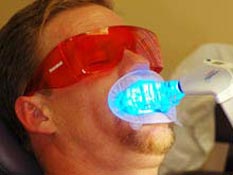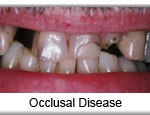Cosmetic dentistry is a phrase we hear a lot of in the media and in advertisements. But, what does it really refer to? And, who is qualified to do these procedures? Cosmetic dentistry is not a specialty and is something that all dentists should strive to perfect in their lifelong professional quest to create a healthful, functional, and esthetically pleasing smile. In general, we all agree that a symmetrical and even line of teeth is attractive. And, white teeth that are naturally uniform in shape and color can be a beautiful feature. After all, your smile is one of the first things that people notice about you: and, as we all know, you often only have one chance to make a good first impression. Unfortunately, sometimes nature throws a curveball and a person’s teeth may be mal-aligned, discolored, or ravaged by disease, or a traumatic accident. For all of these cases dentistry can offer patient’s various ways to restore a healthy, natural and radiant smile.
One of the many ways that we can restore a bright smile is tooth whitening. This is often called bleaching the teeth. There are many different techniques and brand names that all vie for dominance in the market place and for peoples’ attention. However, all of the techniques are very much the same and involve using peroxide based bleach that needs to be in contact with the tooth to lighten its color. Some marketing claims purport to be superior to others; however, all the systems offer similar results. There are three basic ways to bleach the teeth. 1) In-office systems, 2) doctor supplied take-home systems, and 3) over-the-counter products that you can purchase in retail stores. In-office systems cost more; however, they offer faster results and allow the patient access to their doctor if they develop any temporary side effects due to the process. Temporary side effects are mainly limited to cold sensitivity and sometimes spontaneous sensitivity. In all cases, this is reversible, and easily applied fluoride treatments speed the recovery greatly. Doctor supplied take-home treatments require the fabrication of a model of your mouth from a dental impression. Then, a soft custom tray is made that fits over your teeth. It is usually very soft and well tolerated by the patient. A peroxide bleaching gel that is weaker than the in-office solution is placed in the bleaching tray and worn for a prescribed amount of time. Over-the-counter products come in various forms, but the most popular are clear, thin adhesive strips that stick onto the teeth. They are worn for a prescribed amount of time until the desired effect is achieved. All of the methods can be effective; it is often just a matter of patient preference. In-office treatments offer instant gratification.
Common questions related to bleaching are about damage to the tooth structure and if the results are permanent. Bleaching has been around for a long time and all of the side effects are transient. The procedure does not harm the tooth enamel and damage it in any way. The results are permanent in that the color of the tooth is changed physically. However, as we continue to age and, depending on our dietary intake, the teeth will continue to darken naturally. This is a natural phenomenon that takes place over years, not months.
One note of caution: if a person has previously placed white fillings or crowns in their mouth, these will not bleach with the natural teeth. Therefore, these crowns and fillings that are in the front of the mouth may need to be changed after bleaching is completed. And, different teeth respond to the process differently. This applies to the degree of side effects and the speed at which the teeth lighten. Some teeth are very resistant to the process and require much more time to bleach than others.
In order for your doctor to know what type of tooth shape and color is appropriate, a thorough consultation and diagnostic work-up should be done. This will often include pre-treatment models that are used to create a wax replica of the planned treatment. The dentist can share this with you and get your response the proposed result; it may even be possible to due a pre-treatment try-in directly in your mouth. Ask you dentist about it.
Finally, it is important to stress that all cosmetic procedures are only as good as the foundation upon which they are built. This means that you should always seek to have a complete examination that will assess the health of all your teeth and the surrounding gums and bone before starting a course of cosmetic dentistry. This may require x-rays of the teeth and various procedures to clean the teeth, as well. Despite the effort, it will be an enhancement of one of your greatest assets, your smile.
Dr. Cohen is an dental implant and cosmetic specialist. He has been practicing dentistry for almost twenty years, and is the former Director of Dental Implantology at Lutheran Medical Center in Brooklyn, New York. A graduate of Columbia University’s School of Dental and Oral Surgery, he received training in advanced implantology from the prestigious Misch Implant Institute and at New York University’s College of Dentistry.
Dr. Cohen is an implant and cosmetic specialist. He has been practicing dentistry for almost twenty years, and is the former Director of Dental Implantology at Lutheran Medical Center in Brooklyn, New York. A graduate of Columbia University’s School of Dental and Oral Surgery, he received training in advanced implantology from the prestigious Misch Implant Institute and at New York University’s College of Dentistry.
Gerald Cohen, DDS
40 West Elm Street,
Greenwich, CT 06830


